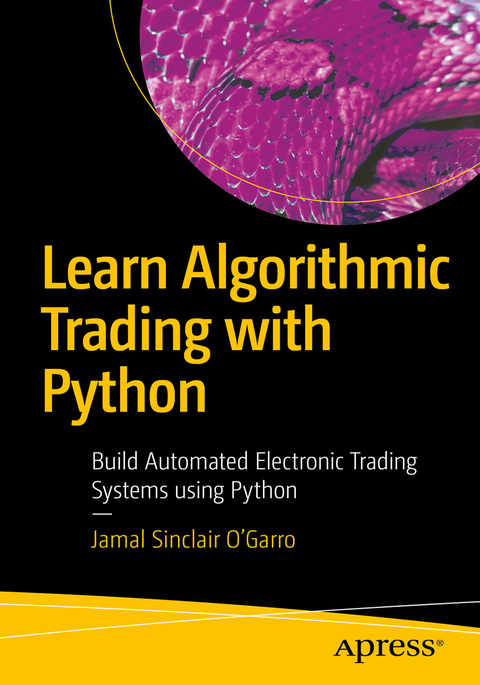
Learn Algorithmic Trading with Python
Apress (Verlag)
978-1-4842-4934-5 (ISBN)
- Keine Verlagsinformationen verfügbar
- Artikel merken
You will create a research environment using Jupyter Notebooks while leveraging open source back-testing software to analyze and experiment with several trading strategies. Next, you will measure the level of return and risk of a portfolio using measures such as Alpha, Beta, and the Sharpe Ratio. This will set the stage for the use of open source backtesting and scientific computing libraries such as zipline, NumPy, and scikit-learn to develop models that will help you identify, buy, and sell signals for securities in your portfolio and watch-list.
With Learn Algorithmic Trading with Python you will explore key techniques used to analyze the performance of a portfolio and trading strategies and write unit tests on Python code that will send live orders to the market.
What You'll Learn
Analyze financial data with Pandas
Use Python libraries to perform statistical reviews
Review algorithmic trading strategies
Assess risk management with NumPy and StatsModels
Perform paper and Live Trading with IB Python API
Write unit tests and deploy your trading system to the Cloud
Who This Book Is For
Software developers, data scientists, or students interested in Python and the SciPy ecosystem
Jamal Sinclair O’Garro is a full-stack Python and Node.js developer with over 10 years of experience working at several top-tier bulge-bracket investment banks and asset managers, a multi-billion dollar hedge fund, and a major securities market maker. His primary focus is designing and building electronic trading software systems. He has experience developing semi-systematic trading, algorithmic trading, backtesting and data visualization programs on Wall Street. Jamal is also heavily involved in the NYC tech scene and runs two of New York City's largest tech meetups. He has been invited to and has spoken at President Barack Obama's White House, the United Nations, and New York University. Jamal has been featured or quoted in major media outlets such as Fortune, Forbes, CNN/Money and TechCrunch. He has also taught software engineering and web development courses at the New Jersey Institute of Technology and Columbia University. In his spare time he likes to shoot photography, learn new functional programming languages, give tech talks, and teach others how to code.
Chapter 01: Finance Flavored Python
Chapter Goal: The aim of this chapter is to provide a high-level overview of Python for newcomers to the language (those coming from MATLAB or R) or those that wish to refresh their knowledge of the language. This chapter also serves as an introduction to the Jupyter Notebook development environment.
No of pages: 30
Sub - Topics:
The Case for Python for Finance
Strings, Lists and Tuples
Loops and Conditionals
Programming
Chapter 02: Exploring NumPy, Pandas and Matplotlib
Chapter Goal: This chapter introduces users to NumPy as it will be used extensively throughout the rest of the text and serves as a good segue into Pandas, which is also heavily leveraged throughout the book.
No of pages : 30
Sub - Topics:
Introduction to NumPy
Exploring Financial Data with Pandas
Visualizing Time-series Data with Matplotlib
Chapter 03: Financial Markets and Electronic Trading
Chapter Goal: The aim of this chapter is to provide a high-level overview of the financial markets and how electronic trading systems work. Readers will be introduced to popular trading concepts such as order books, market orders, limit orders, stop loss orders, liquidity and other important concepts in this area.
No of pages: 30
Sub - Topics:
Financial Market Overview
Electronic Trading Systems
Key Trading Concepts
Chapter 04: Modern Portfolio Theory (MPT)
Chapter Goal: This chapter will serve as a review on Statistics and import concepts in this field that will come up again in the next chapters. We will use StatsModels, Pandas and NumPy Python libraries to perform this review. It will also introduce readers to modern portfolio theory, where they will learn the concepts of Alpha, Beta, Sharpe Ratio, re-balancing a portfolio and the efficient frontier.
No of pages: 30
Sub - Topics:
Introduction to Statistics
Using Python libraries
MPT Concepts (Alpha, Beta, Sharpe Ratio)
Chapter 05: Algorithmic Trading Strategies
Chapter Goal: The chapter on algorithmic trading will provide a high-level explanation of how an algorithmic trading platforms work from gathering market data, feeding this data into models and using programming logic to send live orders to the market. We will also cover several popular trading strategies including but not limited to statistical arbitrage, mean version, momentum and volatility trading in addition to the pros and cons of each.
No of pages: 30
Sub - Topics:
Algorithmic Trading Platforms
Working with Data
Using Programming Logic
Trading Strategies
Chapter 06: Back-testing Trading Strategies with Python
Chapter Goal: This chapter will focus on back-testing the trading strategies that we covered in the previous chapter using Python and several back-testing libraries that have been developed specifically for use in Python-based trading systems and research environments.
No of pages: 30
Sub - Topics:
Testing Strategies
Choosing Libraries for back-testing
Chapter 07: Hedging Positions NumPy and statsmodels
Chapter Goal: This chapter on hedging will focus on the role of correlation and diversification to mitigate risk exposures in addition to popular techniques that are used in industry to hedge away these risks. We’ll leverage NumPy and StatsModels to perform this analysis.
No of pages: 30
Sub - Topics:
Role of Correlation and Diversification
Risk Mitigation Techniques
Chapter 08: Portfolio Risk Management
Chapter Goal: The portfolio analysis chapter will cover how to examine the risks associated with a particular trading strategy and gain deeper insight into a strategy than can be achieved with back-testing alone. Readers will learn which risk metrics are important to portfolio analysis and how to use them to determine portfolio performance. We will focus on the different types of risks that a portfolio can be exposed to and how to mitigate them. Readers will also learn about Beta, bench-marking and how to determine the overall risk of a basket of securities. We will also learn to build Regression and other financial models to improve their algorithms.
No of pages: 30
Sub - Topics:
Risk Analysis
Key Risk Metrics
Managing Portfolio Performance
Factor Analysis
Chapter 09: Financial Modeling in Python
Chapter Goal: The focus of this chapter will be on financial modeling techniques where readers will learn how to build regression and other financial models to improve their algorithms.
No of pages: 30
Sub - Topics:
Regression Models
Improving Algorithm Performance
Chapter 10: Paper and Live Trading with IB Python API
Chapter Goal: This chapter will focus on setting up a paper trading environment that will allow readers to view their trading strategies’ performance in current market conditions without risking real capital. We will leverage the Interface Brokers Python API to create this paper trading environment. We will also be setting up a live trading system that will implement the trading strategies developed, back-tested and paper traded in the previous chapters.
No of pages: 30
Sub - Topics:
Setting up a trading environment
Working with IB Python API
Live Trade Execution
Chapter 11: Unit Testing
Chapter Goal: In this chapter we will cover the importance of unit testing and will add test coverage to our live execution methods to ensure that we catch bugs before we ever deploy our code to production. Having a test suite is an important component to any software system and algorithmic trading systems are no exception.
No of pages: 20
Sub - Topics:
Importance of Unit Testing
Adding Test Coverage
Chapter 12: Trading in the Clouds
Chapter Goal: The chapter will focus on setting up a web server that will be used to run our trading system in the cloud. We will leverage the Tornado Python web development framework for this purpose. We will also learn to deploy the algorithmic trading system to the cloud using Amazon Web Services.
No of pages: 25
Sub - Topics:
Setting up Web Server
Tornado Python Framework
Deploying your Trading System with AWS
Logging and Exception Handling
Chapter 13: Where to Go From Here
Chapter Goal: This chapter will summarize the book and provide a list of suggestions that will help readers continue along in their algorithmic trading journey.
No of pages: 10
Sub - Topics:
Book Summary
Continuous Learning
| Erscheinungsdatum | 17.01.2022 |
|---|---|
| Zusatzinfo | 33 Illustrations, color; 2 Illustrations, black and white; XIV, 276 p. 35 illus., 33 illus. in color. |
| Verlagsort | Berkley |
| Sprache | englisch |
| Maße | 155 x 235 mm |
| Themenwelt | Informatik ► Programmiersprachen / -werkzeuge ► Python |
| Informatik ► Theorie / Studium ► Algorithmen | |
| Wirtschaft ► Betriebswirtschaft / Management ► Finanzierung | |
| Schlagworte | algorithms • Finance • ibpython • matplotlib • Modeling • MPT • NumPy • Pandas • Python • statsmodels • Trading |
| ISBN-10 | 1-4842-4934-8 / 1484249348 |
| ISBN-13 | 978-1-4842-4934-5 / 9781484249345 |
| Zustand | Neuware |
| Haben Sie eine Frage zum Produkt? |
aus dem Bereich


